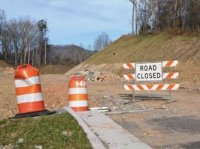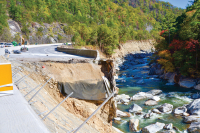Climbing to the top: Local school a hub for outdoor training
 It’s a chilly day on the Tuckasegee River. Air temperature is in the mid-40s, and the water isn’t much warmer.
It’s a chilly day on the Tuckasegee River. Air temperature is in the mid-40s, and the water isn’t much warmer.
Eric Johnson struggles to stand upright, bracing his paddle on the river bottom as a chain of four fellow college students leans on him to traverse the Dillsboro Drop rapid.
It’s a futile effort. The kayak is nowhere in sight, and the current drags across the students’ feet, legs and, finally, waists as the water deepens. Eventually, its whitewater strength intensifies enough to bust the group apart, sending two swimming downstream.
The onlookers, a passel of fellow students and trip leaders, just laugh. And so does Johnson.
“It’s refreshing,” quips teammate Max Carrillo as water streams from his wetsuit. “Like a Fanta on a hot summer day.”
Related Items
It’s an easy comedown because, while the skills learned during that whitewater episode may one day help save a life, for now the students visiting from Virginia Tech and Radford University are in the midst of a purely educational venture, and a thrilling one at that.
“It’s about having different tools, so when one tool fails you have another one,” said Justin Padgett, instructor for the swift water rescue course and co-founder of Landmark Learning, the Cullowhee-based outdoor training school administering the course. “A lot of what we do is to help our students develop judgment, and they develop judgment with experience.”
It’s that attitude that has caused Andy Borak, outdoor programs coordinator for Radford, to work with Landmark time after time.
“I think it’s the hands-on experience,” he said.
From backcountry camping trips to real-feeling medical emergency scenarios to tipped-over kayaks in whitewater rapids, experience is a linchpin of the Landmark education. The school offers a variety of outdoor certification programs with a vision of becoming the leading education resource for outdoor recreation professionals spanning a multitude of disciplines.
Students get some paper-and-pencil instruction hours, sure, but at least half the time, they’re outside, busy practicing the skills that fall under the course title. That was a relief to Olivia Klein, who has spent the past few years leading rock climbing and mountain bike trips. She took Wilderness First Responder training at Landmark’s Cullowhee base last week.
“Spending 8 to 5 in a classroom all day is kind of hard,” said Klein. “Especially when you’ve been out of high school for a while. You go, ‘Oh my gosh, how?’”
Beyond the schoolhouse
But while Padgett never wants to change the hands-on focus of the school, he does want to change the perception that an institution has to offer reading, writing and ‘rithmatic to be a school.
“We want to be seen by all the colleges and universities that we are like them,” Padgett said. “We are not a subcontractor or an outfitter or any of those things. We are a school.”
It’s a bold declaration born from an even bolder move that Padgett and his wife Mairi made in 1996, the same year they married.
That’s when they founded Landmark with a staff of two — namely, themselves, though a couple of seasonal teachers pitched in, too — an apartment that doubled as an office and a first-year roll of 46 students.
At that point, they were just a young couple trying to make a go of it. Now, they have built a 40-acre campus in the woods near Cullowhee, a veritable outdoor training empire replete with campsites and bunkhouses, a 1,200-square-foot classroom and trails for running, biking and hiking. More than 2,000 students per year take courses with Landmark, which now employs 30 people. In addition to their headquarters, Landmark also has several satellite locations, including sites in Boone, Knoxville, Charlotte, Asheville and Atlanta, and they take their courses to more than 100 locations nationwide, even crossing national boundaries to teach in Ecuador, Columbia and Canada.
But that’s not a stopping point. In December, Landmark became the first outdoor school in the country to earn a national education accreditation, given from the Accrediting Council for Continuing Education and Training. It’s a distinction that took three years of research, onsite evaluations, paperwork and waiting, and that, Padgett said, “was probably one of the hardest things I’ve done, ever.”
The end result is both a rubber stamp to Landmark’s educational excellence and a tool that will allow the company to ramp up its collaboration with colleges and universities around the globe.
Accreditation makes it easy for students to earn college credit for the courses they take, and it helps Landmark funnel the students who first experience the outdoor recreation profession through their classes into the appropriate university programs. The idea is to be a middleman between students, colleges and the outdoors, furthering the interests of all three entities.
“I think it’s about ratcheting it up to a level of professionalism that has been our goal since 1996,” Padgett said.
Spreading the word
Because, while a recreation professional’s office more often takes the form of a backcountry trail or craggy cliff than it does a cubical, Padgett believes it’s a career in which professional skills and attitudes are just as important as they are to a lawyer, a store manager or a teacher.
“We never want to have people get hurt or sick,” said Rob Barham, filling up on soup back at headquarters in Cullowhee. Another session with his Wilderness First Responder class would begin soon. “But the better prepared we are for it, the more we can mitigate negative outcomes.”
Outside the building, 16 students aged 18 to 50 lounged in the sun, waiting for day six of the nine-day WFR course to resume. Unlike the Virginia college students gearing up for swiftwater rescue training a few miles away in Dillsboro, the ranks of the wilderness medicine course had come from places as distant as Texas, Ohio and Florida — and as close as Landmark’s backyard.
“We’re out there every day working in the forest, usually in a backcountry setting, an hour away from medical help, so it’s just knowledge I’ve been wanting to gain for a while,” said Sylva resident Dan Bryson, a forest technician for the National Park Service.
Whether you live in Carolina or Columbia, you never know when a routine excursion can turn serious. Maybe that’s why Landmark’s reach extends that far. Their instructors travel from Louisiana to Florida to Maine, and sometimes even to Columbia and Ecuador. Barham believes that scope is partly due to Landmark’s growing reputation as a clearinghouse for outdoors training of all varieties.
“Landmark offers this kind of depth and breadth of certification training that’s kind of available through one institution,” Barham said. “That’s not what you’d normally find.”
The more typical scenario is for an organization to offer a singular type of training, whether it be swiftwater rescue or Leave No Trace ethics. Often, instructors are trained in just that one field. Landmark instructors, by contrast, are often cross-trained in multiple outdoor disciplines.
“Our teachers are super-knowledgeable, and they’re really fun and really energetic, and they also work really well together,” said Klein, a student in the WFR course.
Landmark’s got that part of it down to the point that they’re even able to offer an entire semester of outdoor courses, a six-week bonanza of seven certification courses that kicks off for the second time in mid-May. Students who complete it can earn up to nine transfer credits.
All about the people
Having a quality staff is key to making it all work, Padgett said. When he and Mairi founded Landmark, one of their goals was to assemble a staff of talented, dedicated people who would stick around for the long haul, rather than moving on after a year or two.
They’ve got that now, Padgett said, pulling staff members from the school’s ever-growing network of alumni and also just from out of the blue.
One of last week’s wilderness responder instructors, Dan Payton, was a former student. He moved to Western North Carolina last year as soon as the opportunity came up, but Barham was one of those out-of-the-blue hires.
Padgett first met him in Ecuador, where he was teaching a course with Landmark. Barham was there on a kayaking trip, but malaria had grounded him on a hammock in the Amazon Basin. The class came over to get some real-life experience assessing a malaria case, and once they got to the point that pleasantries were possible, Padgett discovered that Barham was from Bryson City.
“That’s how we find most of our people,” Mairi said of the many avenues by which staff find Landmark. “Well, they’re usually not suffering from malaria.”
Since then, Barham has become one of Landmark’s 22 full-time instructors, helping the school meet its mission of students-first education.
“One of my favorite parts of teaching is the variety of people I interact with,” he said. “I feel like I actually get to know these people.”
That’s important, because each student is coming from a different place, with a different reason for taking the course.
Some need the certifications required for work, others are planning backcountry excursions and want it for their own use, and still others want it as a back-pocket tool in case of emergency or as a gateway to a longer career in outdoor recreation.
So, the instructors pause frequently to call on raised hands and clarify the points most relevant to their students’ specific situations. In-between calling out instructions and spitting facts and guidelines to their class, of course. One minute in class with Landmark staff, and it’s clear they know their stuff.
“What if they don’t know CPR?” one student asked as Payton set up a scenario in which two people alternate administering CPR to an unresponsive person.
“You teach them,” Payton replied promptly. “Put your hands on his chest and press down,” he barked to the student he’d selected to demonstrate how to “teach” CPR. “I need you to count to 30. I can’t hear you. Count to 30!”
“Some of the scenarios feel really real,” said WFR student Jessie Nosworthy, a counselor in Jackson County Schools whose program for at-risk students often involves outdoor activities.
Reaching the limits
And that’s the point. Prepared as you might be, there’s always a limit to what you can do, especially when all the forces of nature are involved. So, while Landmark courses aim to teach and equip students to come out of those overwhelming situations victorious, they’re also designed to teach limits.
“We want them to know what their limit is,” Padgett said, “so they don’t leave feeling like a superhero.”
Because superheros minus superpowers are better known as loose cannons, and cannons are dangerous. As Johnson’s crew plowed into the Dillsboro Drop on the Tuckasegee, Padgett and his co-instructor Jason Carter called after them, saying that of course they could do this, keep going, come on, just hold on.
All the time, though, the instructors knew the inevitable outcome: the current would strengthen, the students’ line would break and they’d fly downstream until hitting calmer waters.
“They have to have some moderate success, some moderate failure and we have to connect that for them,” Padgett said.
So, once the wetsuit-clad group of Virginians stood safely on shore, Padgett debriefed them on all those things that determine whether a rapid is or is not wadeable — principally, depth, type of river bottom and the speed of the current.
It’s through a grounded understanding of the seeming minutia of outdoor proficiency that Landmark seeks to raise up the next generation, both of outdoor professionals and of economic drivers for Western North Carolina.
“What we seek to do is have our students believe that what we do is a business,” Padgett said. “Outdoor recreation is a business, and it needs to be business-minded. In the U.S., the amount of money that’s spent on outdoor recreation is epically ridiculous. Recreation is what funds Western North Carolina.”
In the end, though, Landmark’s success comes from its effort to serve the individual, its commitment to meet its students where their skills end and then give them the tools to go further.
“They put students first,” Payton said. “It’s very big into ‘what is the student walking away with?’ That’s what’s important.”
For more information about Landmark Learning, including course offerings, visit www.landmarklearning.edu.
The Landmark adventure
Trail description: Outdoor training school based in Cullowhee offers professional development courses spanning a plethora of outdoor recreation and emergency medicine fields.
Length: 18 years old and counting.
Duration: 4 hours to 3 weeks, depending on certification.
Elevation gain: From a starting elevation of 46 students and two instructors, it now climbs to 2,100 students per year and 22 instructors.
Key features: Wilderness First Aid, Emergency Medical Technician, Essentials of River Safety and Rescue, Leave No Trace Master Educator and numerous others. Founded in 1996 by a pair of Western Carolina University students. The only outdoor training school in the United States to have earned a national education accreditation.
Trailhead directions: Heading toward Cullowhee on N.C. 107, make a left onto Old Cullowhee Rd and another on Cane Creek Rd. Drive 1.3 miles until the road dead-ends into a parking lot.









